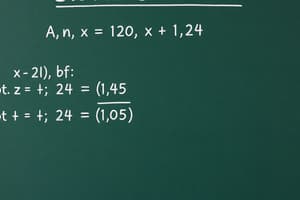Podcast
Questions and Answers
What does Slovin's formula help to estimate?
What does Slovin's formula help to estimate?
- The maximum sample size
- The minimum sample size required for a survey (correct)
- The total error in survey results
- The population mean
Which variable in Slovin's formula represents the desired margin of error?
Which variable in Slovin's formula represents the desired margin of error?
- N
- n
- e (correct)
- r
If the population size (N) is 5000 and the desired margin of error (e) is 0.02, what is the approximate sample size (n) calculated using Slovin's formula?
If the population size (N) is 5000 and the desired margin of error (e) is 0.02, what is the approximate sample size (n) calculated using Slovin's formula?
- 200
- 196
- 2500
- 490 (correct)
What happens to the required sample size (n) if the desired margin of error (e) is decreased?
What happens to the required sample size (n) if the desired margin of error (e) is decreased?
Which of the following is an assumption of Slovin's formula?
Which of the following is an assumption of Slovin's formula?
What impact does a larger population size (N) have on the sample size (n) using Slovin's formula, assuming the margin of error (e) remains constant?
What impact does a larger population size (N) have on the sample size (n) using Slovin's formula, assuming the margin of error (e) remains constant?
Which of the following represents a common value for the desired margin of error (e) when using Slovin's formula?
Which of the following represents a common value for the desired margin of error (e) when using Slovin's formula?
When utilizing Slovin's formula, if the desired margin of error is reduced to 0.01 (1%), what should be expected about the sample size (n)?
When utilizing Slovin's formula, if the desired margin of error is reduced to 0.01 (1%), what should be expected about the sample size (n)?
What is one assumption underlying the use of Slovin's formula?
What is one assumption underlying the use of Slovin's formula?
What would happen if the population size (N) were fixed at 1000 while the margin of error (e) is adjusted from 0.05 to 0.03?
What would happen if the population size (N) were fixed at 1000 while the margin of error (e) is adjusted from 0.05 to 0.03?
Using Slovin's formula, what happens to the calculation of sample size (n) if the population variability is high?
Using Slovin's formula, what happens to the calculation of sample size (n) if the population variability is high?
What does the variable 'e' in Slovin's formula represent?
What does the variable 'e' in Slovin's formula represent?
If you have a population size of 500 and a desired margin of error of 0.04 (4%), what step should be taken next using Slovin's formula?
If you have a population size of 500 and a desired margin of error of 0.04 (4%), what step should be taken next using Slovin's formula?
What is the primary reason for using Slovin's formula in research?
What is the primary reason for using Slovin's formula in research?
Flashcards are hidden until you start studying
Study Notes
Purpose of Slovin's Formula
- Estimates minimum sample size for surveys or studies.
- Based on desired margin of error and confidence level.
Formula Overview
- Sample size (n) is calculated using the formula:
n = N / (1 + Ne²) - Variables defined:
- n = required sample size
- N = total population size
- e = desired margin of error (as a decimal)
Steps for Application
-
Determine Population Size (N):
Identify the total number of individuals targeted for the study. -
Set Desired Margin of Error (e):
Smaller margins increase required sample size; common values include 0.05 (5%) and 0.03 (3%). -
Calculate Sample Size (n):
Substitute N and e into the formula and solve for n to obtain the required sample size.
Example Calculation
- For a population of 1000 with a desired margin of error of 5%:
n = 1000 / (1 + 1000 * 0.05²)- Resulting sample size = approximately 286.
Important Considerations
- Slovin's formula is straightforward and widely accepted for sample size estimation.
- Assumes simple random sampling method.
- More complex sampling designs may necessitate different mathematical approaches or statistical techniques.
- Variability within the population and precision requirements are critical factors in determining appropriate sample size.
Purpose of Slovin's Formula
- Estimates minimum sample size for surveys or studies.
- Based on desired margin of error and confidence level.
Formula Overview
- Sample size (n) is calculated using the formula:
n = N / (1 + Ne²) - Variables defined:
- n = required sample size
- N = total population size
- e = desired margin of error (as a decimal)
Steps for Application
-
Determine Population Size (N):
Identify the total number of individuals targeted for the study. -
Set Desired Margin of Error (e):
Smaller margins increase required sample size; common values include 0.05 (5%) and 0.03 (3%). -
Calculate Sample Size (n):
Substitute N and e into the formula and solve for n to obtain the required sample size.
Example Calculation
- For a population of 1000 with a desired margin of error of 5%:
n = 1000 / (1 + 1000 * 0.05²)- Resulting sample size = approximately 286.
Important Considerations
- Slovin's formula is straightforward and widely accepted for sample size estimation.
- Assumes simple random sampling method.
- More complex sampling designs may necessitate different mathematical approaches or statistical techniques.
- Variability within the population and precision requirements are critical factors in determining appropriate sample size.
Studying That Suits You
Use AI to generate personalized quizzes and flashcards to suit your learning preferences.




